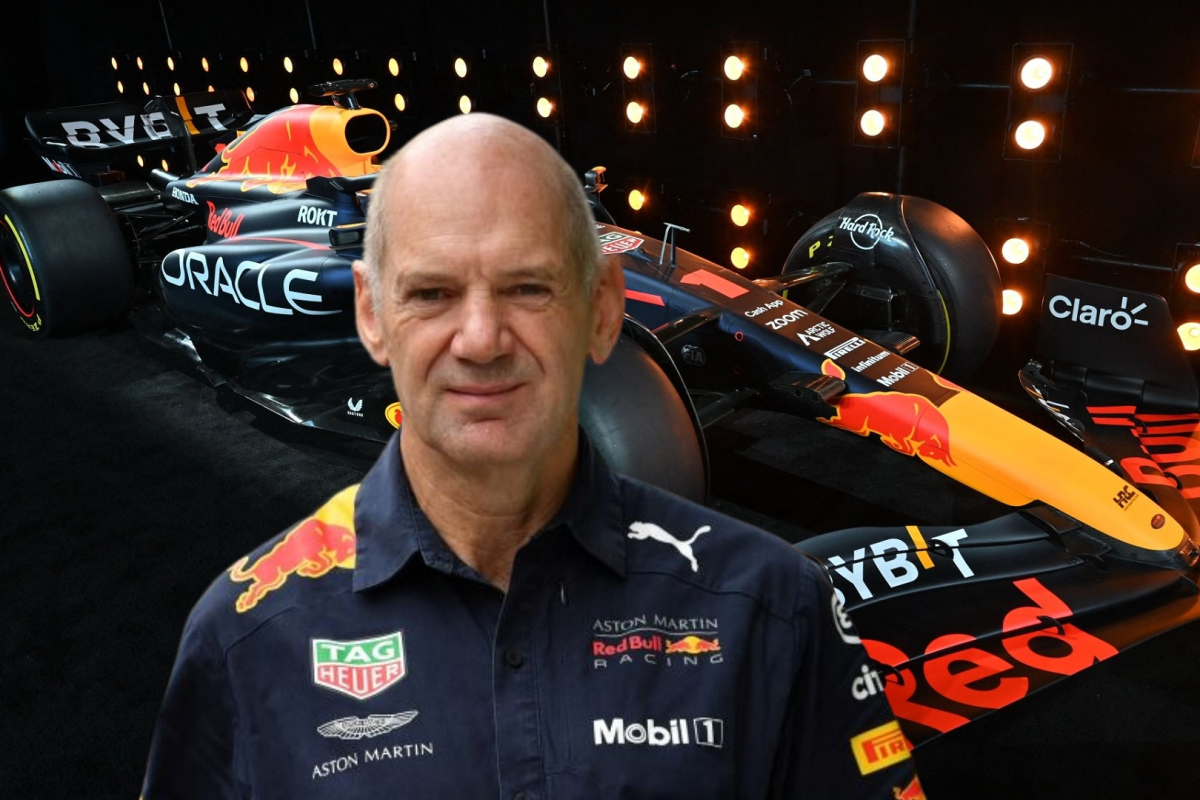
Newey's RB19 floor is 'F1 AERO PORN' claims ex-Red Bull guru
Newey's RB19 floor is 'F1 AERO PORN' claims ex-Red Bull guru

When Sergio Perez decided to bin it in Monaco Qualifying, we got the first shots of the RB19 floor.
Compared to the Ferrari and Mercedes, it looked as if it was a piece of art deifying the standard logic and conventions of aerodynamic design. So we took up the challenge, designed some of the features of the RB19 floor on our own model car and performed a Computational Fluid Dynamics (CFD) simulation on it to understand what might be happening.
And I have to say, it surprised me.
In this two-part article, we deep dive into the potential aero mechanisms of the RB19 floor. In the first part we will focus on the First Lateral Diffuser and in the second part we will look at the Second Lateral Diffuser.
Before we delve deeper, let's start by saying that the CFD results that will be presented are not F1 grade, however, they are good enough to speculate potential aero mechanisms of F1 cars - which is ultimately the point of the exercise.
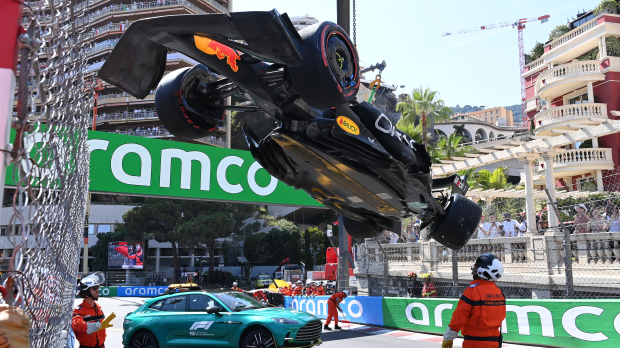
READ MORE: Why Adrian Newey is the BEST and WORST thing to happen to F1
The First Lateral Diffuser
We all know how the front floor of the car acts like a venturi tunnel if you take a side-view section of the floor, tons of youtube videos explain that. However, what many miss out on is how the front floor works laterally.To understand how the front floor of the RB19 potentially works as a lateral diffuser, we need to capture some of its features and understand what they are doing.
The Front comprises of :
1. Front Floor Outwashing Strakes 2. Front floor kick, where there is a local drop in static pressure 3. Expanding configuration of Keel and Innermost Strake 4. Floor Edge Winglets
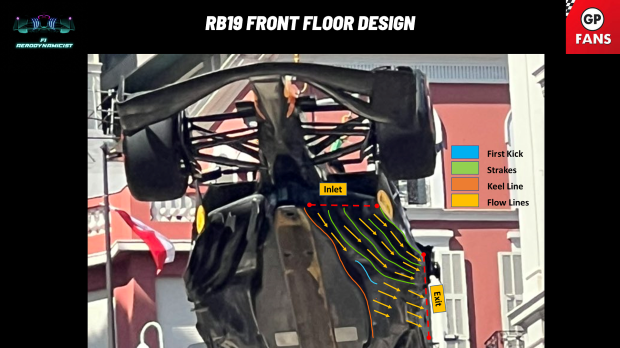
What is Lateral Expansion?
Lateral expansion in simple terms is the drop in suction that is obtained due to the expansion of diffuser volume laterally. The same principles of vertical expansion apply, the more you expand, the higher drop in static pressure you obtain at the throat.But pushing the expansion mechanism is not easy, as the vortex structures that sustain the diffuser expansion have to travel in an adverse pressure gradient, in which if the vortex is pushed hard, it tends to break down within the diffuser causing a transitory stall.
Since this is an open system, the more you are able to expand laterally, the higher mass flow rate you entrain via larger velocity, which results in larger static pressure drops accompanied by stronger and possibly healthier strake vortices, thus generating larger downforce.
Front Floor Outwashing Strakes
To simplify how the floor generates downforce, you can think of two mechanisms at play. First is the conventional venturi tunnel explanation. Although one has to be very careful in applying this, as the Venturi effect is strictly for closed systems such as pipes. The floor of an F1 car works more like an Open Venturi System which has different aerodynamic characteristics.
The second mechanism is how delta wings generate the lift produced via the pressure drop introduced by strong vortices. Exploiting this second effect is where I believe the RB19 thrives.
To generate the strong vortex structures, the front strakes are intricately designed and iterated. To get their design right, an engineer needs to account for the local flowfield upstream, to understand how the front strake curvature affects the generation of the vortex and to understand at what point do you shed the vortex such that it synergies with the vortices coming from the other strakes so that it has beneficial effects downstream.
Additionally, because these strakes are outwashing they naturally promote lateral flow expansion
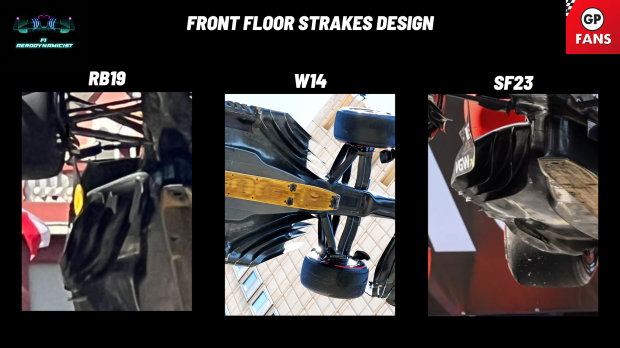
The Front Floor Kick
The Front Floor Kick is a very unique feature of the RB19 which I’m sure the other teams will be scratching their heads around.The ‘kick’ basically refers to an aggressive transition region around the throat which results in a large local drop in static pressure. The kick is primarily present in the region between the innermost strake and the keel curvature.
After the kick, the inner strake aggressively expands. Also, keep in mind that the most important vortex in the floor is also shed by the innermost strake, so its design is a critical in terms of performance.
So what unique benefits would the front floor kick provide? This design could be useful to:
1. Generate local front load by using the volume expansion present between the Strakes and Keel. 2. Manage your primary vortex strength and swirl (ratio of the tangential and axial velocity of a vortex) which determines vortex stability as it travels downstream.
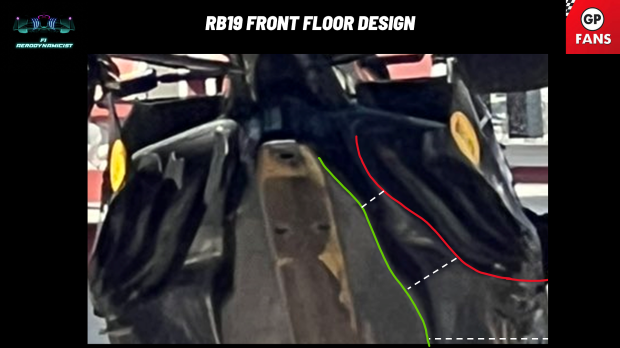
Elliptical Vortex Structures in the Floor?
One inquisitive feature we noticed in our simulation was the elliptical arrangement of the vortex structures in the floor when the floor is relatively flat and close to the ground.This is an arrangement that both Ferrari and Mercedes run with. The vortex structure pattern also becomes elliptical due to the vertically converging nature of the floor. These two vortices initially are side by side creating a flow vector which promotes outwash from the front floor, thus promoting the lateral expansion philosophy of the front floor.
However, the elliptical vortex itself is not as effective in dropping the pressure as compared to a merged circular vortex. From pictures we have seen that Red Bull’s RB19 main floor is much higher than that of Ferrari, so I'll not be surprised if Red Bull has given up some performance related to ground height and been able to make up a lot of performance via the right vortex merging mechanism, rather than being limited to these type of dual elliptical vortex structures.
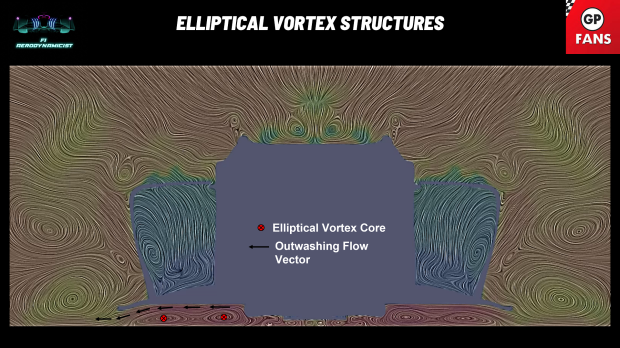
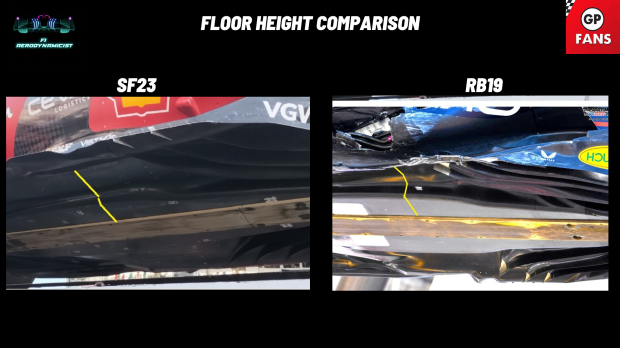
Novel Floor Edge Winglets
The Red Bull RB19 has the most strikingly different floor edge winglets. It's an up-washing cascade which will generate local load via the upwash. But why is Red Bull not using gurney configurations on their front floor like the rest of the grid?Well, our simplified version of this cascade on our CFD model gave us an interesting insight. Our CFD results hinted to us that the tip vortex shed from the inner edge of the cascade promotes outwash continuing the whole lateral expansion philosophy further downstream where the strakes end.
So basically you are using these Floor Edge Winglets to extend the length of the floor which can be used for flow expansion. Incredibly smart!
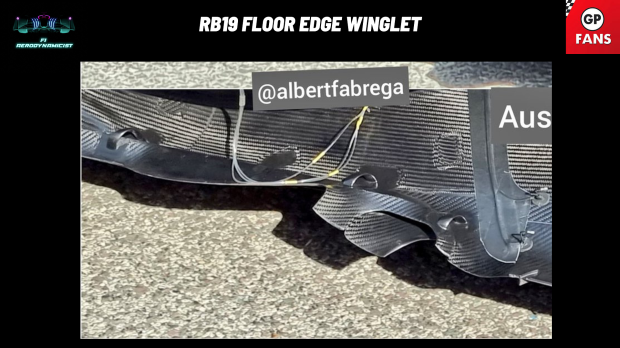
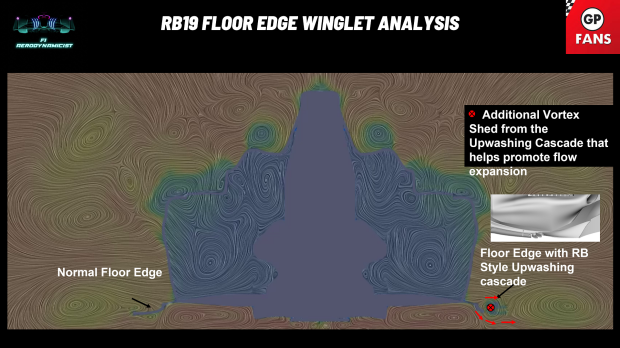
In the next article, we will talk about the “Second Diffuser” that's present in the floor, I promise it's not as conventional as you might think!
Shubham Sangodkar is a former F1 Aerodynamicist with a Master's in Racing Car Design specialising in F1 Aerodynamics and F1 Data Analysis. He also posts aerodynamics content on his YouTube channel, which can be found here.
READ MORE: Who is Helmut Marko? The genius behind Red Bull rise to power
Related
Change your timezone:
Latest News

Hamilton in Ferrari F1 SHOCK after team snub revealed
- 29 minutes ago

Newey set for CRUCIAL meeting over Red Bull future
- 1 hour ago

F1 News Today: ‘Absolute b******s’ Newey claims slammed as Norris INJURED while partying
- 3 hours ago

Hamilton hit with SURPRISE Ferrari claim as new Cullen relationship blossoms - GPFans F1 Recap
- Yesterday 23:57

Current F1 star qualifies for world championship race on two wheels
- Yesterday 22:57

Ricciardo given HUGE boost after upgrade claim
- Yesterday 21:57
Related news

Newey tipped to POACH key Red Bull staff if he joins F1 rivals

Ricciardo makes five-race admission in bid to survive F1 axe

Red Bull is 'burning' after Horner and Marko display

Verstappen 'to meet Mercedes over SHOCK 2025 move as Red Bull exit clause revealed'
F1 Standings

Drivers
- Oliver Bearman
- Charles Leclerc
- Carlos Sainz
- Lando Norris
- Oscar Piastri
- Pierre Gasly
- Esteban Ocon
- Sergio Pérez
- Max Verstappen
- Alexander Albon
- Logan Sargeant
- Lewis Hamilton
- George Russell
- Nico Hülkenberg
- Kevin Magnussen
- Fernando Alonso
- Lance Stroll
- Valtteri Bottas
- Zhou Guanyu
- Daniel Ricciardo
- Yuki Tsunoda
Races
-
 Gulf Air Grand Prix of Bahrain 2024
Gulf Air Grand Prix of Bahrain 2024
-
 Saudi Arabian Grand Prix 2024
Saudi Arabian Grand Prix 2024
-
 Grand Prix of Australia 2024
Grand Prix of Australia 2024
-
 MSC Cruises Grand Prix of Japan 2024
MSC Cruises Grand Prix of Japan 2024
-
 Grand Prix of China 2024
Grand Prix of China 2024
-
 Miami Grand Prix 2024
Miami Grand Prix 2024
-
 Gran Premio dell'Emilia Romagna 2024
Gran Premio dell'Emilia Romagna 2024
-
 Grand Prix of Monaco 2024
Grand Prix of Monaco 2024
-
 Grand Prix du Canada 2024
Grand Prix du Canada 2024
-
 Gran Premio de España 2024
Gran Premio de España 2024
-
 Grand Prix of Austria 2024
Grand Prix of Austria 2024
-
 Grand Prix of Great Britain 2024
Grand Prix of Great Britain 2024
-
 Grand Prix of Hungary 2024
Grand Prix of Hungary 2024
-
 Grand Prix of Belgium 2024
Grand Prix of Belgium 2024
-
 Heineken Dutch Grand Prix 2024
Heineken Dutch Grand Prix 2024
-
 Grand Prix of Italy 2024
Grand Prix of Italy 2024
-
 Grand Prix of Azerbaijan 2024
Grand Prix of Azerbaijan 2024
-
 Grand Prix of Singapore 2024
Grand Prix of Singapore 2024
-
 Grand Prix of the United States 2024
Grand Prix of the United States 2024
-
 Gran Premio de la Ciudad de Mexico 2024
Gran Premio de la Ciudad de Mexico 2024
-
 Grande Prêmio de São Paulo 2024
Grande Prêmio de São Paulo 2024
-
 Heineken Silver Las Vegas Grand Prix 2024
Heineken Silver Las Vegas Grand Prix 2024
-
 Qatar Grand Prix 2024
Qatar Grand Prix 2024
-
 Grand Prix of Abu Dhabi 2024
Grand Prix of Abu Dhabi 2024
About GPFans
GPFans is a multi-platform, multi-language brand dedicated to Formula One coverage. We bring you all the ins and outs of the sport, 24/7, everything from up-to-the-minute news and features to the latest viral stories and clips.We believe that a new generation of exciting, outspoken drivers will make F1 more popular than ever before, and we want to give our users access to as much of their heroes as possible, on and off the track. From Lewis Hamilton to Max Verstappen, Daniel Ricciardo to Sebastian Vettel, we provide in-depth analysis of every every Grand Prix in the season, from Australia to Abu Dhabi.
With Formula One under the new ownership of Liberty Media, how the sport is being covered is evolving, and GPFans will look to be at the heart of this progression into new media, as one of the fastest-growing sites covering the king of motorsports.
Follow us on your favorite social media channel
Corporate & Media
 Innovatieweg 20C
Innovatieweg 20C7007 CD, Doetinchem, Netherlands
+31645516860


















 Gulf Air Grand Prix of Bahrain 2024
Gulf Air Grand Prix of Bahrain 2024  Saudi Arabian Grand Prix 2024
Saudi Arabian Grand Prix 2024  Grand Prix of Australia 2024
Grand Prix of Australia 2024  MSC Cruises Grand Prix of Japan 2024
MSC Cruises Grand Prix of Japan 2024  Grand Prix of China 2024
Grand Prix of China 2024  Gran Premio dell'Emilia Romagna 2024
Gran Premio dell'Emilia Romagna 2024  Grand Prix of Monaco 2024
Grand Prix of Monaco 2024  Grand Prix du Canada 2024
Grand Prix du Canada 2024  Gran Premio de España 2024
Gran Premio de España 2024  Grand Prix of Austria 2024
Grand Prix of Austria 2024  Grand Prix of Hungary 2024
Grand Prix of Hungary 2024  Grand Prix of Belgium 2024
Grand Prix of Belgium 2024  Grand Prix of Azerbaijan 2024
Grand Prix of Azerbaijan 2024  Grand Prix of Singapore 2024
Grand Prix of Singapore 2024  Gran Premio de la Ciudad de Mexico 2024
Gran Premio de la Ciudad de Mexico 2024  Grande Prêmio de São Paulo 2024
Grande Prêmio de São Paulo 2024  Qatar Grand Prix 2024
Qatar Grand Prix 2024  Grand Prix of Abu Dhabi 2024
Grand Prix of Abu Dhabi 2024